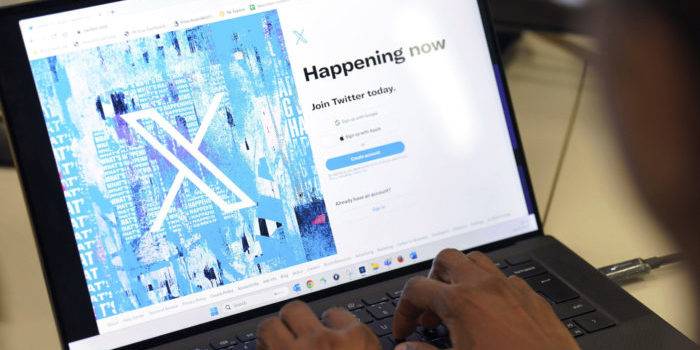(Headline USA) Elon Musk has unveiled a new “X” logo to replace Twitter’s famous blue bird as he follows through with a major rebranding of the social media platform he bought for $44 billion last year.
The X started appearing at the top of the desktop version of Twitter on Monday, but the bird was still dominant across the smartphone app. In response to questions about what tweets would be called when the rebranding is done, Musk said they would be called Xs.
Some warn the change could alienate users and turn off advertisers, leaving the microblogging site vulnerable to new threats—including rival Meta’s new text-based app Threads, which directly targets Twitter users.
Musk had asked fans for logo ideas and chose one, which he described as minimalist Art Deco, saying it “certainly will be refined.”
He replaced his own Twitter icon with a white X on a black background and posted a picture of the design projected on Twitter’s San Francisco headquarters.
“And soon we shall bid adieu to the twitter brand and, gradually, all the birds,” Musk tweeted Sunday.
The X.com web domain now redirects users to Twitter.com, Musk said.
Musk, CEO of Tesla, has long been fascinated with the letter and had already renamed Twitter’s corporate name to X Corp. after he bought it in October.
The billionaire is also CEO of rocket company Space Exploration Technologies Corp., commonly known as SpaceX. He started an artificial intelligence company this month called xAI to compete with ChatGPT. And in 1999, he founded a startup called X.com, an online financial services company now known as PayPal.
Musk’s son with the singer Grimes is also called “X,” although the boy’s actual name is a collection of letters and symbols.
Musk’s Twitter purchase and rebranding are part of his strategy to create what he’s dubbed an “ everything app ” similar to China’s WeChat, which combines video chats, messaging, streaming and payments.
Linda Yaccarino, the longtime NBC Universal executive Musk tapped to be Twitter CEO in May, posted the new logo and weighed in on the change, writing on Twitter that X would be “the future state of unlimited interactivity—centered in audio, video, messaging, payments/banking—creating a global marketplace for ideas, goods, services, and opportunities.”
X is the future state of unlimited interactivity – centered in audio, video, messaging, payments/banking – creating a global marketplace for ideas, goods, services, and opportunities. Powered by AI, X will connect us all in ways we’re just beginning to imagine.
— Linda Yaccarino (@lindayaX) July 23, 2023
It could be a good idea, said Paolo Pescatore, a tech and media analyst and founder of PP Foresight.
“People are now getting increasingly frustrated with a slew of apps, so driving usage all towards one destination will increase engagement and ultimately make it easier for them,” he said.
Experts, however, also predicted the new name will confuse much of Twitter’s audience.
Wiping out Twitter’s brand name recognition that was built up over 15 years is an “extremely risky move,” because it means Musk is ”essentially starting over while its competition is afoot,” said Mike Proulx, a research director at global market research company Forrester.
Twitter users pointed out that few people refer to Alphabet, Google’s parent company since 2015. Facebook renamed itself Meta in 2021, but it hasn’t gotten much traction.
But Pescatore said it might be the right time for the sweeping rebranding that Musk seems to have in mind.
“The removal of Twitter from existence will be difficult for many users to understand,” Pescatore said.
However, “maybe it is time for something new in light of the negative sentiment surrounding the company,” he claimed. A new start over this challenging period of major disruption and appeal to new audiences.”
That disruption includes a slew of Musk’s earlier changes, most recently on limits for tweet views, which sparked criticism that they could drive away more advertisers and undermine its cultural influence as a trendsetter.
The new threshold is part of an $8-per-month subscription service Musk rolled out earlier this year in an attempt to boost Twitter revenue. Revenue has dropped sharply since Musk took over the company and laid off roughly three-fourths of the workforce to slash costs and avoid bankruptcy.
While the company, which notably colluded with intelligence agencies and the Biden administration to aggressively censor conservative critics prior to Musk’s purchase—has become somewhat less censorious, it has yet to live up to the “free speech” bastion he claimed.
Many conservative accounts continue to receive algorithmic suppressions or “shadow bans” that limit their reach, and Twitter’s censors continue to demonstrate arbitrary and inconsistent standards for enforcing their community guidelines with respect to matters like threats, hate speech, obsecenity and profanity.
After Twitter censors in late may attempted to renege on a deal with the Daily Wire to stream Matt Walsh’s bombshell documentary What Is a Woman?, Musk wound up intervening directly in the matter, promoting at least two top-level censors to resign in apparent protest.
Adapted from reporting by the Associated Press

